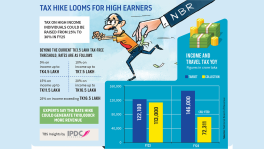Study challenges social distancing efficacy in indoor settings

The risk of contracting Covid-19 indoors despite maintaining social distancing is higher than imagined even while wearing a mask as a new study shows that several factors are not taken into consideration while maintaining distance as great as 60 feet.
Massachusetts Institute of Technology (MIT) professors Martin Z Bazant and John W.M. Bush has reportedly developed a method of calculating exposure risk to Covid-19 in an indoor setting that factors in a variety of issues that could affect the transmission, including the amount of time spent inside, air filtration and circulation, immunization, variant strains, mask use, and even respiratory activity such as breathing, eating, speaking or singing.
The research question long-held Covid-19 guidelines from the US Centers for Disease Control and Prevention and the World Health Organization in a peer-reviewed study published earlier this week in Proceedings of the National Academy of Science of the USA, reports CNBC.
Pathogen-laced droplets travel through the air indoors when people talk, breathe or eat.
Those droplets from one's warm exhalation mix with body heat and air currents in the area to rise and travel throughout the entire room, no matter how socially distanced a person is, the study highlighted.
"We argue there really isn't much of a benefit to the 6-foot rule, especially when people are wearing masks," Bazant said in an interview.
"The distancing isn't helping you that much and it's also giving you a false sense of security because you're as safe at 6 feet as you are at 60 feet if you're indoors. Everyone in that space is at roughly the same risk, actually," he noted.
The important variable the CDC and the WHO have overlooked is the amount of time spent indoors. "The longer someone is inside with an infected person, the greater the chance of transmission," Bazant added.
The MIT faculty highlighted that opening windows or installing new fans to keep the air moving could also be just as effective or more effective than spending large amounts of money on a new filtration system.
"What our analysis continues to show is that many spaces that have been shut down in fact don't need to be. Often times the space is large enough, the ventilation is good enough, the amount of time people spend together is such that those spaces can be safely operated even at full capacity and the scientific support for reduced capacity in those spaces is really not very good," Bazant said.
According to Bazant, 6 feet social distancing rules that inadvertently result in closed businesses and schools are "just not reasonable".
"This emphasis on distancing has been really misplaced from the very beginning. The CDC or WHO have never really provided justification for it, they've just said this is what you must do and the only justification I'm aware of is based on studies of coughs and sneezes, where they look at the largest particles that might sediment onto the floor and even then it's very approximate, you can certainly have longer or shorter range, large droplets," he said.


 Keep updated, follow The Business Standard's Google news channel
Keep updated, follow The Business Standard's Google news channel
















